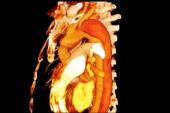Type A Aortic Dissection Tied to Greater Mortality in Women
To improve outcomes, physicians should be alert to potential symptoms and act quickly.

While more common among men, type A aortic dissection (TAAD) is associated with substantially higher rates of in-hospital mortality among women, according to new data. Women also tend to present with more advanced disease with intramural hematoma, periaortic hematoma, or complete or partial false lumen thrombosis as well as hypotension or coma.
Similar to MI, “time is of the essence” with TAAD because “it carries a mortality rate of about 1-2% per hour for the first 48 hours,” senior author Thomas Gleason, MD (University of Maryland Medical Center School of Medicine, Baltimore), told TCTMD.
The sex discrepancies found in terms of presentation suggest “that there may be a difference in the time from onset of symptoms to definitive diagnosis in females compared to males,” he said. “If we can reduce the time to diagnosis and treatment, we will likely reduce mortality. That's probably the most important point I take from this study. I hope that it can invoke a greater awareness among diagnosing physicians on the front lines . . . to have a lower threshold to rule out dissection in the context of symptoms that occur with dissection.”
The data also indicate a potentially “different trigger point” for women to seek medical care when they begin experiencing symptoms or for diagnosing physicians to respond to women compared with men with potential TAAD. “In other words, a woman may develop the same symptom as a man, but the presentation in the woman doesn’t trigger the same level of urgency by the patient or for a diagnostic workup to rule out dissection—thus creating the potential for delay in diagnosis,” Gleason said. “For such a lethal disease as aortic dissection, this is a concern.”
You come in with a primary complaint of chest pain, the first responding physician needs to be thinking, ‘This could be an aortic dissection.’ Thomas Gleason
Commenting on the study for TCTMD, Benjamin Youdelman, MD (Maimonides Medical Center, Brooklyn, NY), who works with the aortic disease awareness campaign Think Aorta US, said, “I'm surprised that women are presenting so late, because I will tell you that the symptoms associated with aortic dissection are not subtle. These are often the most dramatic, the most overwhelming, and the most significant abnormal discomforts symptomatology that any patient has ever experienced. And yet the women are not presenting to the hospital. That's shocking to me.”
Higher Mortality Among Women
For the study, published online last week ahead of print in the Journal of Thoracic Surgery, Lauren V. Huckaby, MD (University of Pittsburgh Medical Center, PA), Gleason, and colleagues looked at 2,823 TAAD patients (65.7% men) from the Interventional Cohort of the International Registry of Acute Aortic Dissection database who underwent either operative repair or a surgical approach as part of a hybrid repair between 1996 and 2018.
On average, women were older (65.4 vs 58.6 years; P < 0.001) and more likely to present with intramural hematoma (19.4% vs 13.2%; P < 0.001), complete false lumen thrombosis (17.2% vs 10.2%; P = 0.001) or partial false lumen thrombosis (24.8% vs 19.4%; P = 0.039), or pericardial (49.6% vs 39.8%; P < 0.001) or pleural effusion (15.3% vs 9.2%; P = 0.007). A higher prevalence of shock (31.3% vs 22.2%; P < 0.001) and altered consciousness (11.5% vs 7.5%; P = 0.001) also were identified in women compared with men.
Men more often underwent complete arch replacement, a Bentall procedure, and aortic valve replacement, while median times for cerebral perfusion and total cardiopulmonary bypass were longer compared with women.
In-hospital mortality was greater in women compared with men (16.7% vs 13.8%; P = 0.039), but postoperative complications were comparable with the exception of acute renal failure, which was lower in women. At 5 years, Kaplan-Meier estimates were similar for survival (82.6% vs 85.9%) and freedom from reintervention (87.8% vs 87.6%).
Over the study period, procedural techniques like ascending aortic cross-clamping, aortic valve-sparing root replacement, and hemiarch replacement increased significantly in both sexes. Additionally, antegrade cerebral perfusion became more common, whereas use of retrograde cerebral perfusion lessened.
On multivariate analysis, there was a trend toward higher in-hospital mortality in women (OR 1.40; 95% CI 1.00-1.98), but this disappeared when only including patients in the last decade of enrollment (OR 0.93; 95% CI 0.54-1.62).
The results suggest “that progress in TAAD management has resulted in narrowing the previous mortality gap between the sexes,” Huckaby and colleagues write. “Nevertheless, sex-specific differences in TAAD presentation should prompt an individualized approach to make further strides in reducing perioperative mortality, which remains high.”
Bringing Aortic Disease to the Forefront
Gleason said the data were not able to illuminate why women show up with more-advanced presentations, suggesting that it could be due to factors related to patient stoicism as well as physicians not responding quickly enough.
“There's a whole spectrum of presentation, but when a patient comes in with signs and symptoms that are within the spectrum of those seen with aortic dissection, somebody has to think of it,” he said. “You come in with a primary complaint of chest pain, the first responding physician needs to be thinking ‘This could be an aortic dissection’ and has to rule it out.”
Likewise, Youdelman said a physician encountering a patient with TAAD symptoms “should have lightbulbs, flashing lights, and all kinds of stuff going off. But unfortunately, . . . an emergency room physician over the course of 2-4 years might see one or maybe two patients who have an aortic dissection.”
Improvement in care for TAAD across the board needs to start with education, said Youdelman. “Number one, there is no patient type for an aortic dissection, except to say that it's more common in men than women. . . . The only consistent piece of information is that if someone has a family history of aortic dissection, aortic aneurysm, unexplained sudden death, or if they have a cerebral bleed, which is an indication of a cerebral aneurysm in the family and they have these strange symptoms, they need to be worked up for an aortic dissection.”
“If we could diagnose everyone quicker,” added Gleason, “we would save more lives, not just women.”
The next step will be figuring out why women are presenting further along in the disease course. “Is it because they are not seeking medical care early enough, or is the problem more on the receiving end in the emergency room?” he asked. “There may be other important factors to tease out.”
Youdelman also encouraged physicians to put aortic disease more at the forefront of their thinking when assessing patient histories. “I think the fact that aortic disease is probably underappreciated, underdiagnosed, and therefore aortic dissections continue to be a significant problem is something that needs to come up into people's thinking when patients are in the office to ask these very pointed questions,” he said. “Because everybody usually asks heart disease, stroke, diabetes, and they stop there. But the other two are cancer and aortic disease, both of which kill people, so why stop at the three as opposed to asking all five?”
Yael L. Maxwell is Senior Medical Journalist for TCTMD and Section Editor of TCTMD's Fellows Forum. She served as the inaugural…
Read Full BioSources
Huckaby LV, Sultan I, Trimarchi S, et al. Sex-based aortic dissection outcomes from the international registry of acute aortic dissection. Ann Thorac Surg. 2021;Epub ahead of print.
Disclosures
- This work was supported in part by the NIH and the Thoracic Surgery Foundation.
- Gleason reports a financial relationship with Abbott.
- Huckaby reports no relevant conflicts of interest.




Comments